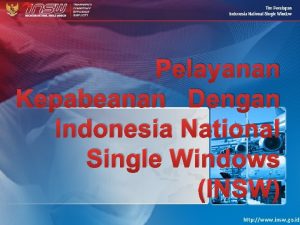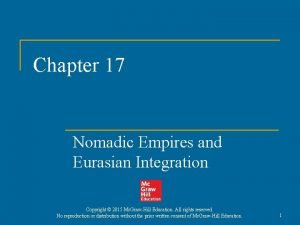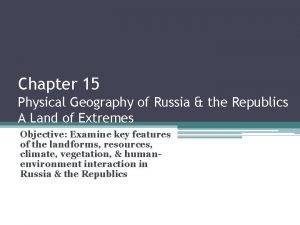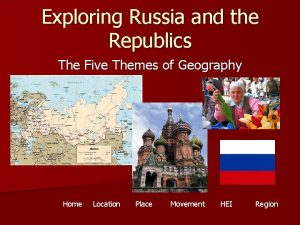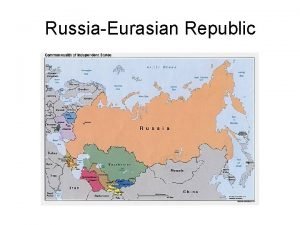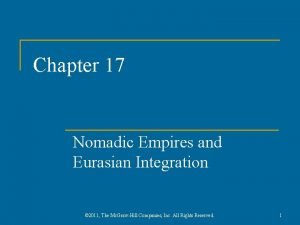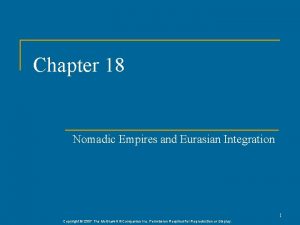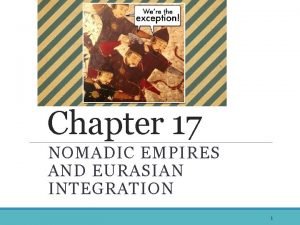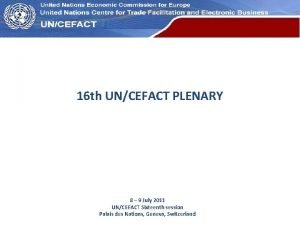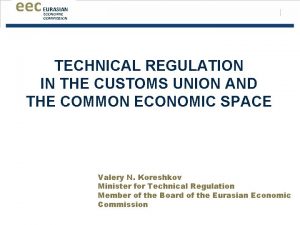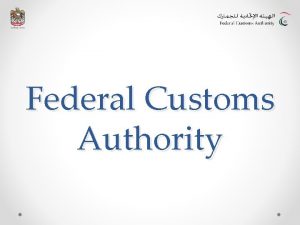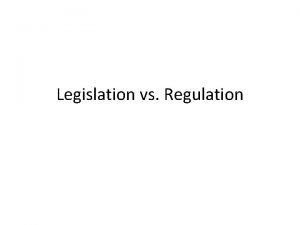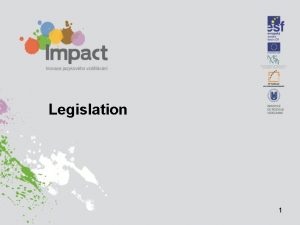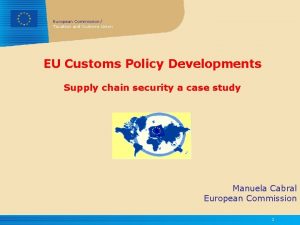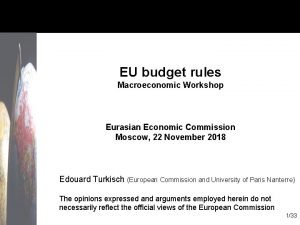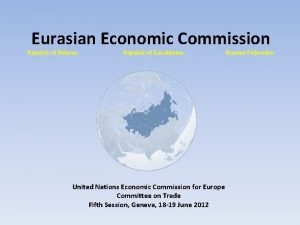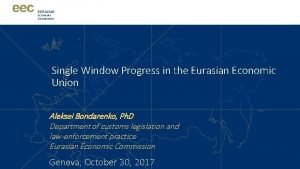e Eurasian Economic Commission Department of Customs legislation













- Slides: 13

еeк Eurasian Economic Commission Department of Customs legislation and law-enforcement practice CUSTOMS REGULATION IN THE CUSTOMS UNION OF REPUBLIC OF BELARUS, REPUBLIC OF KAZAKHSTAN AND RUSSIAN FEDERATION director of the Department of Customs legislation and law-enforcement practice of the Eurasian Economic Commission Mr. Dmitry Nekrasov (Belgium, Brussels 12. 11. 2014)

22 Phases of formation of the Eurasian Economic Union Beginning of functioning of the Eurasian Economic Union Treaty on the Eurasian Economic Union Beginning of functioning of the Common Economic Space and the Eurasian Economic Commission Declaration on the Eurasian economic integration Agreement on the Eurasian Economic Commission Creation of the Customs Union 1994 1995 1996 1999 2000 2003 2007 … 2010 2011 2012 2014 1 Jan. 2015 Agreement on the Commission of the Customs Union Agreement on creation of a single customs territory and formation of the Customs Union Agreement on formation of the Common Economic Space Agreement on creation of the Eurasian economic union Agreement on the Customs Union and the Common Economic Space Agreement on deepening of integration in economic and humanitarian areas Agreements on the Customs Union Lecture of the President of the Republic of Kazakhstan H. E. Mr. N. Nazarbayev about the Eurasian Union at Moscow State University

3 The Customs Union Single customs territory Customs Union Commodity Classification of Foreign Economic Activity, Common Customs Tariff and other single measures regulating foreign trade Single trade regime with third party countries The allocation of customs duties between the Member States of the Customs Union The single rules of country origin and customs valuation of goods The single customs legislation defining the unified customs clearance Absence of the customs control at the internal borders between the Member States of the Customs Union

The Eurasian Economic Union • population of the Eurasian Economic Union is 172, 6 million; • the territory is more than 20 million square kilometers; • (GDP) is 2. 389, 2 billion. USD 4| 4 The implementation of the Treaty on the Eurasian Economic Union provides: - the unity of the rules and methods of researches (tests) and measurements while performing the procedures of mandatory assessment of conformity; - single sanitary-epidemiological and hygienic, veterinary (veterinary-sanitary), quarantine phytosanitary requirements and norms to ensure the plant quarantine; - coherent policies to protect the rights of consumers; - implementation of coordination in the field of trade in services with third parties; - a coordinated (harmonized) transport policy; - the prospect of creating a common market of transport services in the fields of automobile, air, water and rail transport; - cooperation in the field of industry; - coordinated agricultural policy; - cooperation in the field of harmonization of a labor migration policy within the Union, and others.

Customs regulation in the Eurasian Economic Union The Customs Union and the Common Economic Space The Eurasian Economic Union 2010 2016 Customs Code of the Customs Union (old Customs Code) Customs Code of the Eurasian Economic Union (new Customs Code) 2015 Treaty on the Eurasian Economic Union (enters into force) 5| 5

Basic approaches of the Customs Code of the Eurasian Economic Union ü the priority of the electronic customs declaring; ü the possibility to perform customs operations relating to registration of the customs declaration and release of the goods automatically by the information systems of the customs; ü optimization of the data to be stated in the goods declaration and transit declaration; ü the possibility of lodging of the goods declaration without submission to the customs the documents, on the basis of which it was filled out; ü the use of a «single window» mechanism when performing customs operations; ü optimization of prior information of the customs on the goods imported into the customs territory of the Union; ü unification of the features of the customs declaring of the goods conveyed in unassembled or disassembled nature; ü reducing the time of release of the goods up to 4 hours from the time of registration of the customs declaration; ü introducing the possibility to release the goods against security of payment of customs duties and taxes, when the customs control, which began before the release of the goods, has not been completed; ü improvement of the institute of the authorized economic operators; ü clarifying the content and conditions of certain customs procedures; ü simplification of procedures and conditions of moving of certain categories of the goods across the customs border of the Union. 5

Customs declaring Old Customs Code Customs declaring of the goods is performed in writing and (or) electronic form New Customs Code sets up a priority for electronic declaring of the goods. At the same time, there are cases when customs declaring may be made in writing: - when introducing the goods under the customs procedure of customs transit; - in respect of the goods for personal use; - in respect of the means of transport of international conveyance (shipment); - when using transport (shipping), commercial, and (or) other documents as a customs declaration. 6

Automatic registration of the declarations and automatic release of the goods Old Customs Code The customs operations are performed by the customs officials 7 New Customs Code In order to minimize administrative barriers and human factors the draft of the new Customs Code admits performing customs operations automatically by the information system of the customs: - registration of the goods declaration; release of the goods; refusal to release of the goods; customs control in the form of verification of the documents.

Lodging of the goods declaration without submission of the documents Old Customs Code The goods declaration is submitted to the customs with commercial, transport and customs documents, on the basis of which it was filled out. 8 Old Customs Code Taking into consideration the level of development of the customs technologies and information systems of the customs, the new Customs Code excludes submission of the commercial, transport and customs documents to the customs. The new Customs Code is assumed that when the documents, on the basis of which the goods declaration was filled out, are not introduced in consequence, the customs is entitled to enforce payment of customs duties and taxes at the maximum rate based on the maximum value and the most «expensive» Harmonized System code.

Decision of the Supreme Eurasian Economic Council of May 29, 2014 № 68 «Guidelines for the development of a «single window» mechanism in the system of regulation of foreign economic activity» 1. convergence of approaches for the development of national «single window» mechanisms in the Customs Union 2. development of a national «single window» mechanisms 3. mutual recognition of the electronic documents necessary for the external trade 4. organization of information exchange 9

Authorized economic operator ü 1. The new Customs Code has introduced the procedures of granting, suspension and revocation of the AEO status. ü 2. It is introduced a three-level system for categorizing the AEO, which depends on the customs benefits provided. ü 3. Taking into account the recommendations of the World Customs Organization, the conditions for granting the AEO status are revised. For example, the Code introduces the criteria (indicators) of economic operator’s activities, financial solvency, and safety requirements. The old customs code contains six criteria, and the new one – thirteen. ü 4. The new Customs Code extended the categories of the economic operators, which may get the AEO status. For example, customs carriers, customs brokers, customs warehouses may apply to obtain this status. ü 5. It is extended the list of customs benefits provided to the AEO. The old customs code contains three customs benefits, and in the new one this amount is extended to nine ü 6. the validity of the AEO status on the entire territory of the Eurasian Economic Union. ü 7. the possibility of mutual recognition of the AEO status, what determines negotiations with other interested States on mutual recognition. 10

Customs transit Approaches to develop of a customs transit systems in the Customs Union: 1. the accession of the States-participants of the Customs Union to international treaties applicable in the EU, such as the Convention on the simplification of formalities in trade in goods, 1987, and the Convention on a common transit procedure, 1987. 2. the establishment of a transit system of the Customs Union similar to a transit system of the EU with the subsequent integration of the two systems. This mechanism should ensure the effectiveness of the customs control while customs transit and a transparent system for collection of customs payments when goods are not delivered, to allows to apply quickly and objectively sanctions to the violators of customs regulations at customs transit. 11

Thank you! Director of the Department of Customs legislation and law-enforcement practice of the Eurasian Economic Commission Mr. Dmitry Nekrasov info-ndv@yandex. ru www. customs-academy. net
 Eservice.insw.go.id tracking
Eservice.insw.go.id tracking Chapter 17 nomadic empires and eurasian integration
Chapter 17 nomadic empires and eurasian integration Chapter 15 physical geography of russia and the republics
Chapter 15 physical geography of russia and the republics Movement in russia 5 themes of geography
Movement in russia 5 themes of geography What were the 15 countries in the soviet union
What were the 15 countries in the soviet union The mongol empire as a eurasian network
The mongol empire as a eurasian network Chapter 17 nomadic empires and eurasian integration
Chapter 17 nomadic empires and eurasian integration Chapter 18 nomadic empires and eurasian integration
Chapter 18 nomadic empires and eurasian integration Nomadic empires and eurasian integration
Nomadic empires and eurasian integration Aims of secondary education
Aims of secondary education Graduated commission formula
Graduated commission formula United nations economic commission for europe
United nations economic commission for europe Lesson 2 our economic choices
Lesson 2 our economic choices Economic growth vs economic development
Economic growth vs economic development
